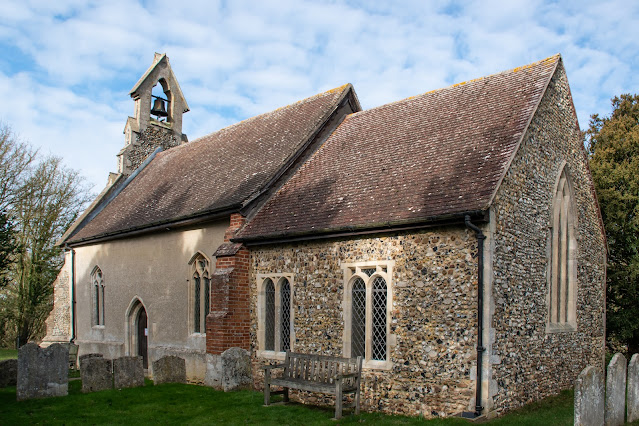Little Finborough and Needham Market _ Parish Churches
A few hours to visit some local churches that have been shut recently due to Covid! It took me a few minutes to find this church, having driven past it once! However, I backtracked to where my map indicated, and parked on the main road. The church is not visible from this point but a walk down the driveway to Finborough Hall, and then turn off through the fields, soon brought me to this tree surrounded, quaint little church.
The Victorians had a lot to do with the church we see now, but it still feels Medieval. Probable of 14C origins and has never had a tower. The west end (above) was rebuilt in 1856, replacing the lath and plaster with the banded pebble wall that we see today.
A view from the North side and the shed like structure on wheels which is an old Shepherds Hut. Supposedly of C19 origin.
The interior of St Mary`s with it`s tiny organ tucked away in the corner and its curious pulpit and reading desk at the front. All in all, a sense of peace and tranquillity, tucked away from todays rat race.
Something I had not come across before and that was "Chalking the Door". Either on Twelfth Night (5 January), the twelfth day of Christmastide and eve of the feast of the Epiphany, or on Epiphany Day (6 January) itself, many Christians (including Anglicans, Lutherans, Methodists, Presbyterians and Roman Catholics, among others) write on their doors or lintels with chalk in a pattern such as "20 ✝ C ✝ M ✝ B ✝ 22", with the numbers in this example referring to the calendar year 2022 and the crosses to Christ. The letters C, M and B stand for the traditional names of the Magi (Caspar, Melchior and Balthazar)
Apparently, the Christian custom of chalking the door has a biblical precedent as the Israelites in the Old Testament marked their doors in order to be saved from death.
Medieval Wall Painting
The fragment to the right of the door to the vestry is a surviving part of a medieval wall painting. This was rediscovered in 2005. An expert in medieval art surveyed it in 2008, although I find it difficult so see what they saw!
`The painting shows a figure with yellow hair and a yellow cloak over a red tunic. The left arm of the figure appears to be bare, with a strap or cuff around the wrist. The figure seems to
be twisting to the left to manipulate some type of instrument, or to pull a rope or cable.
The picture was clearly larger originally, and more of it would have extended to the right, where a memorial plaque is now attached. The remains of a dark border on the painting suggest that it might have been one of a number of narrative scenes within a larger set of paintings.`
From here I traced my steps back to the main road and arrived at Needham Market where I wanted to visit the Parish church situated, unusually, in the middle of the town and hemmed in by other buildings.
The porch and strange pinnacle are Victorian.
Then when you step inside you can immediately see what is arguable one of the best single hammer-beam roofs in England. Not being an expert I can only quote that its span of 30 feet is unusual in a single hammer-beam roof - it would be a double in most places. Just thinking about the carpentry skills required to build this really is breath-taking.
Prior to the C19 restoration, there was a plaster ceiling 16 feet below the roof. It must have come as something of a surprise to see this magnificent roof behind.
The carved angels, to the projecting ends of the hammer beams, were added in 1892 in memory of Major William Dods of Uvedale Hall. Well worth a visit to this rather quirky building if you are in the area.














Comments